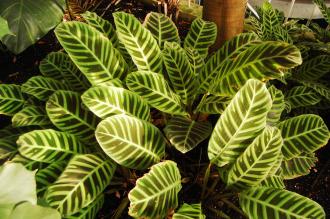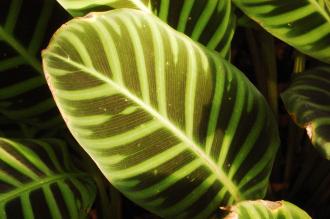
Calathea zebrina (16/01/2016, Kew Gardens, London)
Position: Bright indirect light
Flowering period: Summer
Soil: Moist, well drained
Eventual Height: 80cm
Eventual Spread: 80cm
Hardiness: 10b, 11, 12
Family: Marantaceae
Calathea zebrina is a tropical evergreen perennial with a clump forming habit. Its light and dark green leaves are distinctly stripy, ovate with entire margins, up to 50cm long and 20cm across. Its white/ pale purple flowers appear on short flower stalks at the base of the plant in dense spikes, below the canopy of the plants leaves. Its roots have fleshy rhizomes.
Calathea zebrina, commonly known as Zebra Plant, is native to south east Brazil. In its native habitat it grows as a tropical woodland understory plant.
The etymological root of the binomial name Calathea is derived from the Latin calathus menaing ‘flower basket’, in reference to its flowers. Zebrina is from the Latin and refers to this plant being striped like a Zebra.
The landscape architect may find Calathea zebrina useful as an attractive foliage houseplant, suitable for bright locations.

Calathea zebrina Leaf (16/01/2016, Kew Gardens, London)
Ecologically, Calathea zebrina is of little benefit to UK wildlife.
The Royal Horticultural Society have given Calathea zebrina their prestigious Award of Garden Merit in 1993.
Calathea zebrina prefers moist, fertile, well-drained soils. It tolerates most pH of soil.
When maintaining Calathea zebrina as a houseplant its soil should be watered regularly, although it should never be wet. Watering should be reduced during the winter months. Its preferred active growing temperature rages from between 18ºc to 24ºc, it will tolerate temperatures as low as 15ºc. Feeding with weak fertiliser solution should be carried out every two weeks during the growing season. The leaves may be sprayed with water to increase humidity. Red spider Mites, Mealy Bug and Scale Insects may attack this plant. This plant dislikes sudden temperature drops.

Landscape Architecture

